CTIA, SF, & SAR: Round 2 - The Craziness Continues

Yesterday, CTIA opened Round 2 of its struggle with the elected government of San Francisco. A press release proudly announced
Today, CTIA-The Wireless Association® filed a lawsuit in the U.S. District Court Northern District of California San Francisco Division to block enforcement of the San Francisco “Cell Phone Right-to-Know” ordinance. The ordinance challenges the Federal Communication Commission’s (FCC) determination that all FCC-compliant wireless handsets are safe by mandating that retailers post Specific Absorption Rate (SAR) values. The ordinance misleads consumers by creating the false impression that the FCC’s standards are insufficient and that some phones are “safer” than others based on their radiofrequency (RF) emissions.
The CTIA complaint filed in federal district court is shown at left and linked to the image. In filing this complaint CTIA has engaged 4 different law firms:
Jones Day - “more than 2300 lawyers around the world”
DrinkerBiddle - “We lead complex and sophisticated business transactions and litigate many of the most important legal challenges that our clients face.”
Wiley Rein - “Broadcasting & Cable has recognized Wiley Rein as a ‘powerhouse law firm.’ “
Kirkland & Ellis - “A law firm serving global clients”
CTIA members:
How much is this costing you?
Is that why you don’t have money for buildout of new systems?
Since voice minutes are actually decreasing due to the growth of smartphones which are much more intensive users of your networks and for which SAR values are much lower, why does this really matter now?
The CTIA Complaint drafted by its 4 pricey law firms states that
“the Ordinance is expressly preempted by Section 332(c)(3)(A) of the Communications Act, which prohibits state-imposed conditions on “entry” to the wireless market, including point of sale ‘warning requirements’ and labeling requirements” (p.3, l.7-9)
A quick review of Section 332(c)(3)(A) finds no mention of “ ‘warning requirements’ and labeling requirements’”.
The complaint states in its opening paragraph:
The FCC has stated that any cell phone that complies with the (SAR) standard is safe, regardless of whether its SAR value is at or somewhat below the SAR limit” (p. 1, l. 27-28, emphasis in original)
Yet later on when it discussed this in depth the only reference it gives to FCC’s safety finding is a URL to the Commission’s Consumer & Governmental Affairs Bureau webpage, not to a finding by the Commission in a decision. The section they quote from that webpage is
The FCC requires cell phone manufacturers to ensure that their phones comply with these objective limits for safe exposure. Any cell phone at or below these SAR levels (that is, any phone legally sold in the U.S.) is a "safe" phone, as measured by these standards. The FCC limit for public exposure from cellular telephones is an SAR level of 1.6 watts per kilogram (1.6 W/kg).
I have trouble going from this FCC staff remark on a web page to the CTIA viewpoint stated about: “The FCC has stated that any cell phone that complies with the (SAR) standard is safe, regardless of whether its SAR value is at or somewhat below the SAR limit”.
CTIA’s ever quotable John Walls said in the press release “The problem with the San Francisco ordinance is not the disclosure of wireless phone SAR values – that information is already publicly available.” Yes now it publicly available, but no thanks to CTIA and its membership. Ten years ago they strongly fought Chairman Kennard on this issue when he sought to follow the UK in making the SAR data readily available to the public. They tried to keep the information as buried as possible within the FCC’s ever chaotic website.
But Mr. Walls, why aren’t you also suing or at
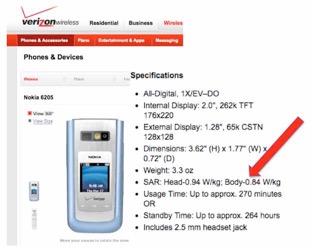
H. R. 5081 Advertising
On 1/23/10, the NSA adopted a Resolution calling on Congress to oppose the FCC’s plan to outsource police communications to a private carrier. The safety of America is too important to privatize to companies more interested in profit than ensuring state-of-the-art public safety communications. History has shown that commercial networks have not provided the level of service necessary in times of need for public safety during critical events.
What is surprising is that if this is so vital to National Sheriffs’ Association, why isn’t the issue even mentioned on the home page of their website? APCO seems to also be in favor of HR 5081, but they at least have a cryptic link to the issue on their home page.
Now for the statement “History has shown that commercial networks have not provided the level of service necessary in times of need for public safety during critical events”, could this NSA and APCO please tell us what they think of the UK experience where a privately operated system provides all public safety communications in the UK and was built under contract with private funding and annual service fees from public safety users?
I know that APCO and others have vilified the TETRA technology used by Airwave for decades, quite possibly at the behest of a major manufacturer whose public safety market share would be threatened by TETRA, but TETRA is now a dead issue in the US for a variety of reasons.
Why do privately operated systems work in the UK but are impossible here? Do the grass root members of both APCO and this NSA actually support this position or is it mainly supported by certain corporate interests?
Snowe/Kerry Spectrum Bill
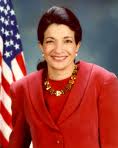

U.S. Senators Olympia J. Snowe (R-Maine) and John Kerry (D-Mass.) today introduced the Spectrum Measurement and Policy Reform Act, comprehensive spectrum reform legislation to modernize the nation’s radio spectrum planning, management, and coordination activities.
“This legislation will lay the groundwork to develop a strong and effective 21st century comprehensive spectrum policy that will provide consumers with additional choices, greater innovation, lower prices and more reliable services,” said Senator Snowe. “Our nation’s competitiveness, economic growth, and national security demand that we allocate the necessary attention to current policy shortcomings, and enactment of this vital legislation will help avert the looming spectrum crisis and allow us to continue to enjoy the boundless benefits of spectrum-based services.”
“Our nation’s airwaves are finite resources, and we need to use them as efficiently as possible,” Senator Kerry said. “This analysis will help us empower innovation, encourage competition, and lower prices for emerging technologies nationwide. Steps like this are essential to expanding broadband internet access while providing a platform where entrepreneurs can create new services and generate jobs. We can and should know how our spectrum is being used and do more to encourage more efficient and productive use. We look forward to working with the Administration and the communications community to move forward with this important legislation.”
Senators Snowe and Kerry, senior members of the Senate Committee on Commerce, Science, and Transportation and longtime champions of spectrum reform, designed the bipartisan measure to complement the Federal Communications Commission's (FCC) National Broadband Plan in promoting more efficient use of spectrum and ensuring that the proper framework is in place to meet the future telecommunications needs of the nation. Specifically, the Spectrum Measurement and Policy Reform Act tasks the FCC and the National Telecommunications and Information Administration (NTIA) to perform much needed spectrum measurements to determine actual usage and occupancy rates. This data will assist policymakers and the public in making informed decisions about future spectrum uses. In addition, the bill requires greater collaboration between the FCC and NTIA on spectrum policy and management related issues, implementation of spectrum sharing and reuse programs, as well as more market-based incentives to promote efficient spectrum use; and, sets a deadline for the creation of the National Strategic Spectrum Plan, which will provide a long-term vision for domestic spectrum use and strategies to meet those needs.
----------
Section 4(b)(1) 0f the bill requires NTIA and FCC to identify based on actual surveys:
(A) 120 megahertz below 4 gigahertz worth of close proximity electromagnetic spectrum that is most feasible for spectrum sharing opportunities for commercial and government users;
(B) 120 megahertz below 4 gigahertz worth of close proximity electromagnetic spectrum that is most feasible for spectrum reuse opportunities for commercial and government users;
(C) 120 megahertz below 4 gigahertz worth of electromagnetic spectrum that is most feasible for temporary or dynamic short-term assignment and use;
(D) 120 megahertz below 4 gigahertz worth of close proximity electromagnetic spectrum that is most feasible for spectrum layering opportunities for commercial and government users.
Section 6(b)(2) lets NTIA withhold spectrum from federal users, charge federal users an annual fee based on market value, and allows incentive awards for agencies that allow their spectrum to be auctioned
Section 6(g) creates an IRAC “shot clock” to require IRAC to “ act within 30 days” on certain items.
My sometimes clients at New America Foundation commented:
"We applaud Senators Kerry and Snowe for their forward-looking efforts to promote spectrum access and mobile broadband innovation," said Michael Calabrese, who directs the New America Foundation's Wireless Future Program. "The Kerry-Snowe bill maps a path to opening enormous amounts of grossly underutilized spectrum, especially federal government bands, for licensed, unlicensed and shared access by the private sector."
The more establishment trade organizations have not commented yet on the bill. I will add this comments when available.
Qualcomm Cognitive Radio Contest on Wireless Microphone Detection
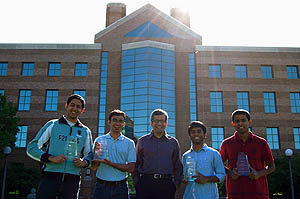
Qualcomm contest winners (from left) Sreeram Kannan, Adnan Raja,
Professor Venu Veeravalli (faculty adviser), Sreekanth Annapureddy,
and Jayakrishnan Unnikrishnan.
(Reprinted with kind permission from Spectral Holes: A blog on Cognitive Radio
by Gonzalo Vazquez Vilar, a doctoral student at University of Vigo, Spain)
A group of students of the ECE Illinois won the 2010 Qualcomm Cognitive Radio Contest. While the 3rd Smart Radio Challenge consisted in developing an integral framework for detection and tracking of different radios on an emergency scenario, the 2010 Qualcomm Cognitive Radio Competition required students to develop and implement algorithms that detect wireless microphone signals within a spectrum band.
While detecting digital television signals using the ATSC (American standard for digital television broadcasting) is not a big deal (given their embedded pilot tones), detecting 200 KHz wide wireless microphone signals with the detection performance required by the FCC proposal becomes a challenge. Qualcomm provided the different teams with training data, consisting on both signal sets with a wideband of 6 MHz and information on the frequencies where microphone signals were located. Contestants had to use this data to find a fitting model for the microphone signals and develop algorithms to detect them. The algorithm was judged based on its performance, novelty and implementation complexity.
The approaches followed by the 14 participating teams were fairly different. For example, the ECE Virginia Tech team:
The students developed a fairly robust solution. They determined a baseline noise correlation matrix from a data set with no wireless microphone signals. To see if a signal is present in a new environment, they compare the new correlation matrix with the baseline matrix using singular value decomposition. If their algorithm determines there is a signal, it calculates the center frequency from the measured auto correlation of the signal."
The winning team (ECE Illinois), advised by V. V. Veeravalli, commented that the key problem was learning to distinguish wireless microphone signals from narrowband interference caused by other electrical devices. They addressed this problem by characterizing the unique features of this narrowband interference.
The University of Illinois at Urbana-Champaign’s website added:
The Qualcomm contest requires students to develop an algorithm and software that detects if a wireless microphone signal is present within a spectrum, so the cognitive devices can avoid causing interference to it. The wireless microphone needs to be protected from interference as it holds the primary license for that spectrum.
However, finding the wireless microphone signals proved harder than they imagined. Raja said that Qualcomm provided the contestants with “training data,” which specified the frequencies where microphone signals were located. Contestants were expected to use this information to learn models and develop algorithms to classify the signals.
“The spectrum they provided was six megahertz wide, but the wireless microphone signal is very narrow, less than 200 kilohertz wide, and it can be anywhere in the spectrum, which makes it hard,” Unnikrishnan said.
“It’s like finding a needle in a haystack,” Raja added. “It’s so narrow, and it can be anywhere in the spectrum.”
Kannan said the key problem was learning to distinguish wireless microphone signals from unintended narrowband interference caused by electrical devices in the vicinity.
"We solved this by identifying features that characterize narrowband interference," Kannan said.
The algorithm was judged based on its performance, novelty and implementation complexity.
“We needed to keep in mind its practical applications, which was hard because we’re used to working with the theoretical,” Kannan said.
The group persisted and developed a strong, unique algorithm that classified signals with good confidence levels, which contributed to their win. If implemented into Qualcomm applications, their algorithm could help target open bandwidth and channel it into use.
“One potential application of cognitive radios is to bring high speed Internet to rural areas where it’s not presently available,” Raja said.
The winning students look forward to the future of their research.
“I think it’s very impactful in this sense. These kinds of competitions help us connect theory to practical applications and even guide futuristic research,” Kannan said. “It makes it all exciting.”
FCC and NTIA Leadership BOTH Send Evasive Letters on Key Spectrum Issues
On July 2, Asst. Sec. Strickling replied to IEEE-USA’s May 6 letter urging FCC and NTIA to work together to clarify what is “harmful interference” since this phrase is used repeatedly in the Communications Act and the only formal definition is one recycled for the ITU that is murky in many practical situations. (FCC has not yet responded to this letter.) In practice, drawn out harmful interference determinations by both NTIA and FCC have significantly delayed access to spectrum for new technologies.
Asst. Sec. Strickling seems to agree with the basic premise of the IEEE-USA letter, saying
“NTIA currently works to establish spectrum rights and responsibilities for all spectrum users, particularly with respect to interference and interference protection, whenever, possible and practical. When we are able to do so, the time taken by long drawn-out interference disputes is shortened or eliminated without detrimentally affecting reasonable expectations of all interested parties, promoting greater access to, and more efficient use of spectrum.
But the letter then goes on to reference an NTIA report that is almost 5 years old: Interference Protection Criteria: Phase 1 - Compilation from Existing Sources, NTIA 05-432, Oct 2005 . This report is a good background study reporting mostly on ITU-R recommendations relating to well known systems. The ITU-R recommendations are not generally binding on FCC and NTIA in the usual case of a domestic system sharing with another domestic system, although they are important in the case of satellite systems and systems near the US and Canadian borders.
The report was supposed to be part of the 2 phase study. Five years ago, the report stated:
In the second phase of this study, NTIA will review the relevant federal government policies and practices regarding IPC and recommend regulatory and technical refinements that may improve IPC application’s scope, utility, clarity, or effectiveness.
That is really the question at hand. Asst. Sec. Strickling,
- Does NTIA have schedule for doing this?
- Will NTIA involve the public in this issue?
- Will it work jointly with FCC on this issue?
On May 28, Senators Rockefeller and Kerry sent Chmn. Genachowski a joint letter:
We are writing to urge you to immediately begin a comprehensive inventory of the use o f radio spectrum by non-federal government licensees and users under the Federal Communications Commission's jurisdiction.
Radio spectrum is a scarce, but valuable resource. As more and more of our communications take place using wireless technology, it is vitally important for us to understand how spectrum is allocated and used. Indeed, gaining a better understanding of how we use spectrum is the first step toward identifying how we can use this resource most efficiently to carry out critical government missions and to help bring more advanced communications services to consumers across the country.

“the general public with access to information about various spectrum bands, including usage and licensee information, mapping and analysis tools, and the ability to browse and download data.”
Chmn. Genachowski,
- Will the “usage” information include information based on any actual observations or just the reformatting of data presently in FCC databases?
- Since cellular carriers do not now report cell site location and coverage data, how will you present CMRS information?
- Current broadcast contours used for Part 73 licensing and used for protection of broadcast spectrum in some contexts are based upon Part 73 propagation models that assure “administrative certainty” for broadcasters but do not realistically portray their actual coverage, will broadcast spectrum use be presented based on these traditional models or based on contemporary readily available propagation models?
FCC Significantly Improves in OPM Employee Survey
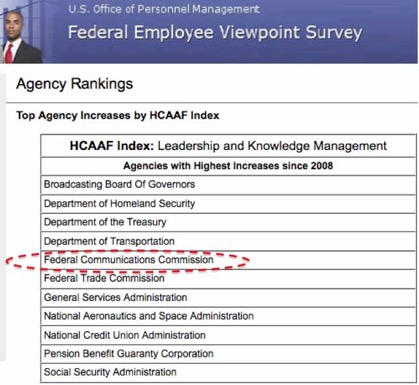
Monday, FCC issued a press release on the results of the 2010 OPM Viewpoint Employee Satisfaction Survey that quoted Chairman Genachowski as saying,
“I am delighted that the FCC has been recognized as the ‘most improved’ federal agency. The survey results reflect the hard work being done throughout the agency to make the FCC a model of excellence in government.
"The FCC’s reform agenda, which builds on the impressive strides made by Commissioner Copps as acting chairman, includes creating new opportunities for employees to provide feedback; improving employee communication through technology and new media; and focusing on leadership development and opportunities for employees. I applaud the work of the FCC management and staff and look forward to more great things to come."
Long time blog readers may recall that this survey, previously called the Federal Human Capital Survey, has been a recurring topic here. A topic in which FCC has done extremely poorly in the past.
In May 2009 we wrote,
“FCC ranked 28th out of 32 ranked small agencies. Its score of 55.0 also put it lower than all the large agencies except the Department of Transportation. The only small agencies scoring worse than FCC were: International Boundary and Water Commission, Selective Service System, Broadcasting Board of Governors, and Federal Labor Relations Authority. Also (only) 20 out of the 216 ranked "agency subcomponents" ranked lower than FCC including FAA, FEMA, TSA, and FCC's neighbor - Bureau of Engraving and Printing.
NTIA was not treated as a subcomponent so there is no data on it.”
Earlier we described how the Commission’s ancien regime had dodged early OPM surveys even though they were a well publicized and admirable Bush 43 Administration initiative. Well FCC is now fully on board and is moving up in the ratings, although Chmn. G. did overreach a bit on the “ ‘most improved’ federal agency” a bit. As the image above from the report shows, OPM only identified FCC as one of 11 agencies with the “highest increases since 2008”.
The raw data shows the very positive improvement since the former chairman left. On the questions “I feel encouraged to come up with new and better ways of doing things”, in 2008 52% of FCC staffers either strongly agreed or agreed, now it is 62%.
On “My work gives me a feeling of personal accomplishment”, formerly 60% either strongly agreed or agreed, now it is 70%.
On “I can disclose a suspected violation of any law, rule or regulation without fear of reprisal”, there was a big jump: formerly 45% either strongly agreed or agreed, now it is 67%. Perhaps this points to the need to have a credible long term inspector general at FCC - a recurring theme in this blog. While it is laudable that there is great improvement here, what can be done to prevent a low score in the future?
There were also large increases in positive responses to both “Arbitrary action, personal favoritism and coercion for partisan political purposes are not tolerated.” and “Prohibited Personnel Practices are not tolerated” making one wonder what was really going on under the ancien regime? Perhaps another indication of what happens when there is not a credible IG in an agency or perhaps this is why the previous chairman did not want a credible IG!
Finally on “I have a high level of respect for my organization’s senior leaders” formerly 38% either strongly agreed or agreed, now it is 62%!
So congratulations to Chmn. Genachowski and the new team on this major turn around!
International Calling Rates: A Case of Market Failure?
For the purpose of regulating interstate and foreign commerce in communication by wire and radio so as to make available, so far as possible, to all the people of the United States, without discrimination on the basis of race, color, religion, national origin, or sex, a rapid, efficient, Nation-wide, and world-wide wire and radio communication service with adequate facilities at reasonable charges, for the purpose of the national defense, for the purpose of promoting safety of life and property through the use of wire and radio communications, and for the purpose of securing a more effective execution of this policy by centralizing authority heretofore granted by law to several agencies and by granting additional authority with respect to interstate and foreign commerce in wire and radio communication, there is created a commission to be known as the “Federal Communications Commission”, which shall be constituted as hereinafter provided, and which shall execute and enforce the provisions of this chapter.
The above are the stated goals of the Communications Act of 1934, as amended. While originally these goals were met mainly through regulation, both the Commission and Congress have found that in most cases competition is more effective in regulation in meeting these goals. Thus § 203 tariff regulation is generally a historic relic. Although my copy of the Act still states in § 201:
“All charges, practices, classifications, and regulations for and in connection with such communication service, shall be just and reasonable, and any such charge, practice, classification, or regulation that is unjust or unreasonable is declared to be unlawful”.
Let me be clear, I think competition has been generally more effective than regulation, but market failure is always a possibility that makes competition ineffective in protecting the public interest and the goals of the Act. There are clear indications that in the international telephony market there has been market failure and that both the wired and wireless carriers are exploiting this to frustrate the goals of the Act.
Let’s focus on the wireless case. I recently was in Singapore and bought a prepaid SIM card from the store closest to my hotel which turned out to be M1 Ltd. (Being Singapore, one of many countries where anonymous prepaid cards are illegal, they sensibly and quickly made a copy of my passport as a prerequisite for buying the card.) The pricing of call was quote interesting: 8¢/minute for both domestic calls and international calls to India, Macau, Bangladesh, Brunei, China, Vietnam, Malaysia, Australia, Thailand, Laos, Hong Kong, New Zealand, Taiwan, Puerto Rico, USA, Russia, Canada, United Kingdom and South Korea. Philippines, Indonesia, and Saudi Arabia were somewhat higher at 22 - 45¢/minute. (These prices are in Singapore currency which is worth about 70% of US currency.)
Now I can see that the cellular network in compact Singapore is very different than that in the US with thousands of miles to cover and lots of rural areas, but I am having trouble seeing how that would affect international calling rates.
So what do US carriers charge? They all have a 2 tier system that pressures you to buy a monthly or annual plan for the privilege of paying market-based rates. If you do not subscribe to their “plan” and make a call in a rush here’s what you pay per minute for calls to the UK:
AT&T $1.29
Sprint $1.59
T-Mobile $1.49
VZW $1.49
So, big 4 US carriers: Do the goals of the 1934 Act apply to you?
FCC: How long will you look the other way while these carriers, and their landline counterparts, charge 1980s AT&T monopoly rates for international calling where the real cost has fallen close to zero and where truly competitive pricing confirm that?
Nokia Cognitive Radio Animation
In the middle of Docket 04-186, TV white space rulemaking, MSTV distributed DVDs of a video, “You Neighbor’s Static” alleging to explain the horrendous consequences of the FCC’s proposals. Sadly, MSTV seems to have withdrawn that video from their website although a vestige remains. MSTV - please repost it for archival value! (If anyone has a DVD of the MSTV video, could you consider posting it to YouTube yourself. I will gladly post a link)
In continuing the oversimplification of the issues, this time from the other side, Nokia has now contributed the video shown above and even made it available on YouTube. MSTV never did that!
Now, Nokia did a better production job than MSTV and is more accurate. However, they got a little carried away with the content and have CR as a cure for many ills. They even claim CR can “enroll your child in a school”. Gee, I went to Singapore for DySPAN in April and nobody mentioned that!
CR has many benefits, although enrolling your children in school is unlikely to be one of them. The fact that Nokia, a pretty establishment company with CTIA members as clients is now openly in favor of it is a positive sign. Maybe all the affected parties can start talking constructively about how to achieve the benefits in a win-win fashion and move away from the types of alarmist positions MSTV took in the past.
Thanks to David Witkowski of the Wireless Communications Alliance, the California-based WCA and the original user of those initials, for pointing this video out to me.
WRC 2012: Suggestions for Enhanced International Radio Regulations May Redefine Some Services

[The following item is reprinted with from the Geneva-based World Radiocommunication Report with their kind permission]
Modest suggestions for enhancing the international radio regulatory framework at the 2012 World Radiocommunication Conference are emerging from preparatory talks during the last four years. The main question under this conference agenda item is whether to continue to base existing applications and the introduction of new technologies on the roughly 40 services defined in the Radio Regulations for the table of frequency allocations, or to find some other basis for regulations and provisions for spectrum management at the international level, said ITU Radiocommunication Bureau Director Valery Timofeev in a May interview.

A European proposal on terrestrial issues suggested changing the definition of the fixed service (FS) to clarify applications allowed, Jeanty said. The proposal consists of modifying the definition of FS to clarify that a receiving fixed station could be at a specified fixed point or at any fixed point in a specified area, according to a preliminary report by the Radiocommunication Bureau (BR).
The method also proposes modification to the consolidated list and tables for use in the application of procedures for “coordination, notification and coordination of frequency assignments and Plan modifications” to allow notification of the circular receiving area for fixed service, the BR report said. The proposal could also affect the BR data processing system TerRaSys, it said. Changes to the data processing system would take about six months, it said.
Another impact of the European proposal is that the submission of a geographical area equal to a country would mean that fixed service receiving stations may operate in the whole territory of a given country, the BR report said. “This may be not in line with the nature of the fixed point-to-area applications, which are normally confined to a limited service area (with exception of few countries with small territories),” it said. No impact was identified on international regulatory aspects of coordination.
An alternative proposal from Canada raised many concerns about the impact on the international regulatory framework, the BR report said. “Therefore, further thorough analysis of the regulatory provisions, which are potentially affected by the proposed changes, would be necessary.” The regulatory impact will be considered during an ITU-R meeting in November. ITU-R talks on convergence of satellite services settled on the idea that the regulations have sufficient flexibility, Jeanty said.
Satellite operators are interested in what constitutes a fixed- and a mobile-service because many satellite bands are shared on a co-primary basis with one or both of these services, AsiaSat told an ITU-R working party meeting last month. AsiaSat said point-to-multi-point applications using ubiquitous terminals were not meant to be deployed under the fixed service category. Operation of point-to-multipoint applications using ubiquitous terminals under the FS category causes interference into fixed satellite service (FSS) operations in bands shared as co-primary, it said.
The operational equivalency of point-to-multipoint applications using ubiquitous terminals and mobile applications, which are notified as either a mobile or fixed service, is one reason why some administrations are today treating FS and mobile service (MS)allocations on an area basis without distinguishing between them, AsisSat said. It is also the motivation for proposals to merge the FS and MS service categories and even in some cases including the broadcasting service category, it said. AsiaSat said the FS and MS service categories should not be merged but that the service categories should be redefined to reflect current usage.
AsiaSat wants to redefine the FS and MS definitions so that point-to-multipoint applications using ubiquitous terminals are included in the MS and specifically excluded from the FS. The FS and the FSS share well, AsiaSat said, but fixed- and broadband-wireless access don’t share well with FSS applications, it said.
AsiaSat thinks the satellite industry could support either a clarification in the present definition of the fixed service that specifically excludes point-to-multi-point applications using ubiquitous terminals, or a redefinition of the fixed service that excludes point-to-multipoint applications using ubiquitous terminals.
ITU-R participants dealing in space radiocommunication applications said changes to the fixed and mobile services in bands shared with space research-, Earth exploration- and meteorological-satellite services may adversely affect coordination with earth stations. Ubiquitous terrestrial systems introduced as a result of changes to the fixed and mobile services in shared bands may also affect space borne receivers, they said. Other participants dealing with remote sensing said changes to the fixed and mobile services leading to introduction of ubiquitous terrestrial systems in bands shared with Earth exploration-satellite (passive), Earth exploration-satellite (active), and meteorological-aids services would also affect
space-borne receivers.
Doug Sicker Rejoins FCC as Chief Technologist

Today, Federal Communications Commission Chairman Julius Genachowski announced Douglas C. Sicker as Chief Technologist of the Commission. Dr. Sicker will reside in the Office of Strategic Planning and Policy Analysis and will advise the agency on technological issues.
“I am delighted that Dr. Sicker is returning to provide the FCC with his broad and deep knowledge about the communications networks and technologies of today and tomorrow,” said Chairman Genachowski. “His technical expertise will help the FCC pursue policies that spur investment, create jobs, promote innovation, and advance our nation’s global technology leadership.”
Currently Dr. Sicker is Associate Professor in the Department of Computer Science at the University of Colorado at Boulder with a joint appointment in the Interdisciplinary Telecommunications Program. He recently served on the Omnibus Broadband Initiative working on matters related to research and development.
I worked with Doug when he was at the FCC in the Hundt era and was very impressed with both his technical skills and his policy knowledge. I recently saw him in Singapore when he was general co-chair of the IEEE DySPAN conference. This is a great selection and I look forward to seeing Doug back in DC on a regular basis.
UPDATE
It seems common knowledge at FCC that Jon Peha, the incumbent Chief Technologist, will be going to the White House’s Office of Science and Technology Policy (OSTP).
Wi-Fi History Book Coming
Here’s their description of the book:
Wi-Fi has become the preferred means for connecting to the internet - at home, in the office, in hotels and at airports. Increasingly, Wi-Fi also provides internet access for remote communities where it is deployed by volunteers in community-based networks, by operators in 'hotspots' and by municipalities in 'hotzones'. This book traces the global success of Wi-Fi to the landmark change in radio spectrum policy by the US FCC in 1985, the initiative by NCR Corporation to start development of Wireless-LANs and the drive for an open standard IEEE 802.11, released in 1997. It also singles out and explains the significance of the initiative by Steve Jobs at Apple to include Wireless-LAN in the iBook, which moved the product from the early adopters to the mass market. The book explains these developments through first-hand accounts by industry practitioners and concludes with reflections and implications for government policy and firm strategy.
• First-hand industry perspectives link the practice of innovation to the theory of innovation
• Shows how successful firm strategy relies on linking innovation to product introduction
• Provides important advice for practitioners and policymakers about designing and applying successful standardisation strategies
Your blogger is a coauthor of one section, but has no financial interest in the book.
UPDATE
The book is now available:
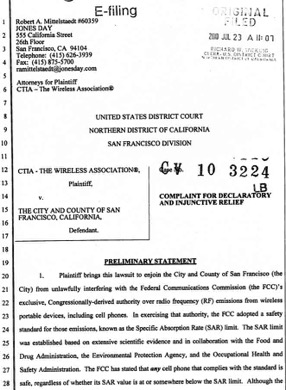


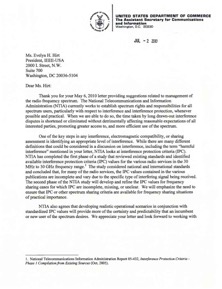
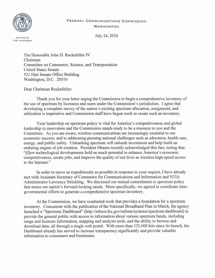

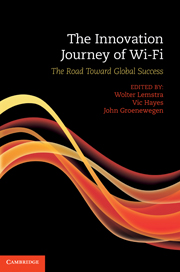



![Validate my RSS feed [Valid RSS]](valid-rss-rogers.png)

